I didn’t post on this earlier. Then came across this great article that said what I had in mind.
Core Inflation Rises – Interest Rates May Follow, by James C. Cooper. Couple of good graphs in the article along with the great discussion.
In May 2011, the core inflation rate was 0.3% while the posted CPI was 0.2%. (more…)
